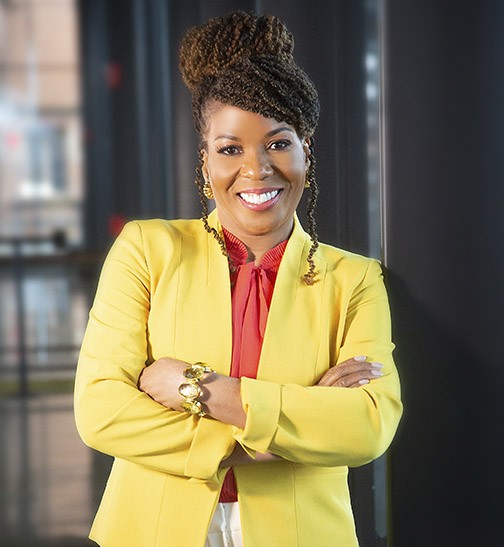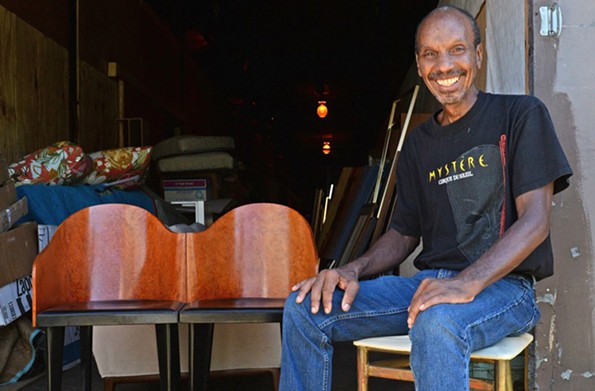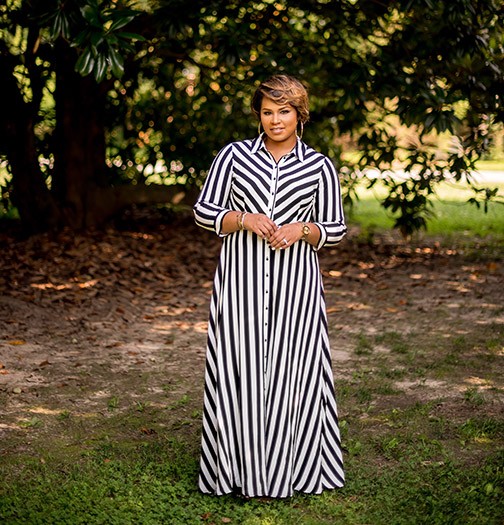Designers, In Living Color | Cover Story | Style Weekly
Dictionaries define the verb design this way: to create, fashion, execute, or construct according to plan. But really, the best design defines itself.
It exists as an art form that imbues beauty into utility, style into function.
A growing consortium of Black designers – including graphic artists, furniture creators and interior space makers – now lend their singular talents to the Richmond region, redefining design on their own terms and ushering in a new school of Black creatives.
Featured here are designers – young and young at heart, gifted and Black – examining the evolving creative strategies they use to make their mark in white-dominated fields.
Karen Hardy, senior designer at Accent Interiors and an interior design instructor at the University of Richmond, started her career in an altogether different field more than 30 years ago.
“I [was] actually a registered nurse,” says Hardy, a veteran designer, window fashions professional and certified Class-C contractor whose facility houses an on-site drapery workroom stocked with a plethora of fabrics and textiles used to create custom window treatments.
“What got me into this profession 25 years ago, was when I was building a house and I wanted everything custom. I love fabric and textiles. I love layers and patterns and everything!” Bitten by the design bug, Hardy left nursing and hit the books. “I went to Sheffield School of Interior Design [renamed the New York Institute of Art and Design in 2013] and learned the foundational basics. I haven’t looked back since.”
When Hardy started, interior design was a field dominated by white people – and by some measures, it still is to this day.
“For a world that celebrates – and often steals from – global culture and diversity, behind the glossy exterior, the interior design industry is ironically and startlingly uniform,” writer Jessica Salter noted in a recent issue of Vogue UK. “From lists of top-50 UK designers to panel speakers to homes that appear in magazine shoots, those featured are often white.” The all-white-everything trend is also apparent in American design circles, including central Virginia.
“I have been around the block, it has not been easy,” Hardy admits. “Early on, when other designers – white designers – were using their names in their company names, I couldn’t do that, because some people would look me up and look at me and discount me because I was Black.”
Hardy’s clever answer to this challenge? She chose the company name, Accent, because of its first letter.
“[That way] it would be first in the white pages,” she says. “That would be their first association and impression of my business.”
Likewise, Angela Wilson Lee, owner of Wilson Lee Interiors, says she’s seen the lack of Black representation in varying aspects of her 25-year interior design career. She does her part to boost the industry’s diversity, helping hopeful Black designers get their foot in the door.
“I purposefully look for interns who are African American. Because when I go to trade events, where we bring interns and assistants to do different things, rarely are any of the interns Black,” she says. “So I want these young designers to get the same experiences as their white counterparts.” Wilson says the Black interns she’s worked with tell her it is often difficult for them to secure internships with design firms.
“Maybe it’s because they’re not being introduced to the right networks, or they don’t know the right lingo because they don’t know anyone personally with a design background,” Wilson says. She relates to this experience personally.
“When I was growing up, I didn’t know what a designer was. I only discovered there was such a thing as interior designers when I was in high school,” she says of her formative years in South Carolina. But an early knack for beautifying her childhood home hinted at her future profession.
“I am the oldest of five kids. My mom was ill, and we were very poor growing up. I was just trying to do my part as the oldest child by cleaning up and trying to make our house look good and pretty. I realized what I did added joy to [Mom’s] life, and I guess I got hooked on that feeling – styling someone’s interior spaces to make them feel happier than they are.”
The connection between a home’s design aesthetic and the homeowner’s emotions played a big role in Wilson’s first role at an Atlanta design firm and spurred her towards making a living helming her own interior design company with a holistic focus.
“My first client had special needs; he had autism,” Wilson says. “My job was to eliminate things in his home that would be a trigger and introduce things that would be more calming for his situation,” such as furniture and decor in soothing colors and textures. Wilson had studied interior design and fashion merchandising at the Art Institute of Atlanta and learned how a living space’s aesthetic can affect health and wellness. But the actual experience of creating such a space, to meet the needs of a real person, showed her the connection “was very real.”
For artist and furniture designer Maurice Beane, that moment of realness appeared more than 30 years ago at a now-defunct Richmond art festival.
“June Jubilee put me on the map,” he says. “It raised my profile as a young artist and furniture-maker and connected me to the arts community in Richmond. I realized I loved furniture design and wanted to incorporate it into my life, entirely.”
By the late 1980s, he was locally treasured for his postmodern design motif and creations. He sold out his entire showing in the 1986 Christmas fundraiser of the Hand Workshop, now the Visual Arts Center of Richmond. And by the end of the decade, he leveled up from a furniture salesman at the downtown Richmond flagship of sprawling department store chain Miller & Rhoads, to a commissioned furniture designer for Harold Zimmerman Design Group, a large furniture manufacturer based in North Carolina. His career in design spans more than three decades and he sees no end in sight.
In April, he’ll lead a huge estate sale at the Ellen Glasgow House, the 19th century Monroe Ward mansion that is named for the Pulitzer Prize-winning author and art collector. He’s always working on design projects and serves as a mentor to emerging designers. Beane – recalling the not-so-long-gone days when white West End clients he’d talked with on the phone balked when he met them in person, assuming that the Black man on their doorstep was a solicitor or deliveryman, not the designer they’d commissioned to create furniture for them – believes things are changing for the better for designers of color.
“People are much more aware of designers and artists of color,” he says in his soft-spoken but serious manner. “[Black designers and artists] have always had tremendous talent and skills; we see evidence of that from back in slavery days and before. But over the last 20 years, there’s been a resurgence of interest in Black artists and designers in the Richmond area. There are a lot more opportunities now.”
A new school of emerging Black designers are taking hold of those opportunities with both hands. And their talents run the gamut of design categories, including creating visual communications for corporate and community groups.
Graphic design is central to both of Shannon Bass’ jobs: She is lead graphic designer at John Tyler Community College and visual strategist and principal designer at Ryano Graphics, the communications and design firm she founded in 2007. Although she earned her chops via a formal journalism and graphic design education at the University of North Carolina – Chapel Hill, Bass says some of the best local and regional Black design talent exist in a shadow network.
“Underground or in a lesser-known light, Black creatives are teaching themselves design, collaborating together and thinking differently,” Bass says. “I think there are a lot of younger [Black creatives] who realize they have the talent for design and they become entrepreneurs” and independent creatives. “They use the internet to train themselves, to hone their skills and brush up their natural talent and skills. I think there’s so many people who do that, it gives an edge to their art and design because it’s authentic.”
The downside, Bass says, is that these emerging designers often lack the connections to access spaces where they will be paid full-time for their work, like advertising agencies, social media management companies or corporations. When Black designers do find roles in these traditional spaces, they are often confronted with the “culture fit” phenomenon.
Bass explains: “Sometimes, it feels like in Richmond, Black creatives need to be totally palatable to white people. So my alma mater has name recognition at many of the agency spaces I’ve worked in before, and that makes me a bit more palatable to white peers. That is not the reality for all of us.”
While attending a conference for Black designers last year, Bass says one presenter’s research showed that hiring processes at agencies nationwide are often based on feeling and relatability.
“They’re going to hire people whom they relate to, whom they would like to hang out with, whom they feel like fit into that culture,” Bass says of the presentation. “If the employees at an agency are majority white and the candidate isn’t, it’s going to be difficult. … If agencies haven’t been exposed to more diverse groups of [designers and creatives], then they are less likely to hire someone who isn’t like them.” These sentiments are echoed in the experiences of Black designers in the state of Virginia and across the country.
Through her latest venture, Black Creatives RVA, Bass aims to spotlight these artists, elevate their work to the mainstream and enable their access to local and national clients seeking innovative designers to help them share their messages, products and content with the world.
Black Creatives RVA is an online directory of Black designers and creatives that Bass launched in February.
“Especially with the national and corporate renewed interest in social injustice and systemic racism, I want to easily connect Black creatives to companies,” Bass says. The website serves as a springboard and portal for Black visual creatives, including graphic designers, illustrators, photographers, creative directors and art directors.
L. Chambers also comes from a communications background and understands the intricate link between a message and its visual medium. She puts her skills to use as lead stylist and home stager at the Bold Interior, a boutique interior styling and sourcing company she launched in December of last year.
“To be very frank, when I walk into a home, I want to know your story,” she states drily. “I want to see art, pictures of your family and objects that tell me who you are.”
To help a home tell owners’ stories, Chambers relies on clients’ personality, needs and global cultural inspiration. Citing interior design’s traditional, Eurocentric standards, Chambers loves incorporating African, Asian and other cultural motifs in her projects and encourages clients to allow their home’s style to reflect their heritage.
“It makes their space feel more meaningful, if they have a personal connection to the design in the home,” she says.
Chambers follows in the footsteps of her aunt, Betty Ann White, who was one of the first African American retail buyers at Miller & Rhoads in the 1980s. Chambers often tagged along to work with Aunt Betty Ann, watching in fascination as she styled merchandise and reviewed inventory for purchase. Chambers holds a fond memory of helping her aunt design the store’s holiday window displays. Aunt Betty Ann is Chambers’ inspiration, and her pioneering work emboldens Chambers to “be my authentic self” in her work, “as a stylist, as an interior designer and as a Black woman.”
Noting the lack of Black designer representation across the industry both locally and nationally, Chambers joined the Black Artists + Designers Guild, which she describes as an extensive network of support and resources for African American design professionals. She, like the other designers mentioned in this issue, emphasizes that most of her peers don’t want their success to hinge on their identities as Black creatives, but on their innate abilities and hard-earned skills. “I like to lead with the fact that I’m a Black designer,” she says. “But we are careful to say that we’re just talented designers, period.”
In March, Chambers will launch a new resource for emerging designers from marginalized communities. It’s called xDesign –pronounced “by design” – a bimonthly online series created to raise the visibility of Black designers and designers of color in Richmond and to give people ways to connect with them. Chambers says local expert designers and veterans of the industry will lend their expertise to the project and up-and-coming creatives will be welcome to share their perspectives and make connections.




